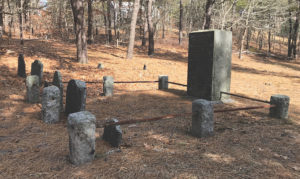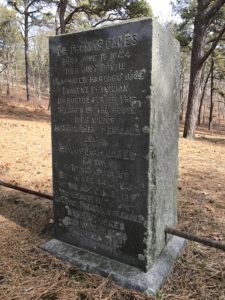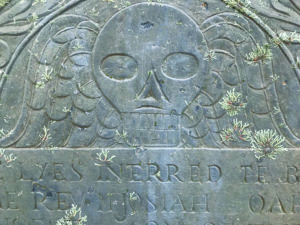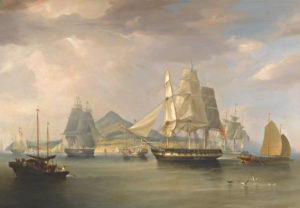
WELLFLEET — In a pretty little corner of town, there is a small, ancient burial ground, its scattering of headstones nestled amid the scrub oak leaves and pine needles. In 1905, the inscriptions in the Chequessett Neck Cemetery were copied and presented to the Mass. Society of Mayflower Descendants for preservation. Even then, more than a century ago, a number of the stones, it was noted, were badly broken and others were illegible.
The cemetery goes by several names. Some call it First Burial Ground or Indian Burial Ground, others Taylor Hill Cemetery or Early Meetinghouse Cemetery. Located on Harrison Street, a dirt road in a quiet neighborhood behind Mayo Beach, there is no hint of the drama buried in the sandy soil, a tangled story of personal and ecclesiastical relationships and a long-simmering internecine dispute that strained community fellowship, pitting orthodox church doctrine against changing times. And also — witchcraft.

Chequessett Neck Cemetery began as a family burial ground on the estate lands of the wealthy and influential Doanes. The two earliest interments were of Capt. Joshua Doane, the son of John Doane Esq. and Hannah (Hobart); and Joshua’s wife, Mary (Freeman) Doane, the daughter of Nathanial Freeman and Mary (Howland).
Married on Oct. 13, 1715, Mary Doane died just nine months later, three months before her 18th birthday. In November 1716, Joshua, with five other crew members, was drowned on a voyage from East Harbor, Truro, to Billingsgate. He was just 20 years old. In the aftermath of their family tragedy, John and Hannah Doane were embroiled in what came to be known as the Stone-Osborn controversy.
By 1720, Eastham, originally known as Nauset, was making plans for a new meetinghouse to replace the original at Cove Burial Ground, which had served the entire community since 1646. The growing population in the north part of town, known as Billingsgate, some 20 miles from the meetinghouse, clamored for its own parish after unofficially managing its own ecclesiastical affairs for years. In 1723, Billingsgate was set off from Eastham as its North Precinct.
The first business of the new parish was to build a meetinghouse — said to have been but 20 feet square — and to permanently “settle” a minister. The name Early Meetinghouse Cemetery suggests that this was the site of that structure. The Rev. Josiah Oakes, who had been ministering informally at Billingsgate since 1714, was invited to become the ordained minister.
A graduate of Harvard College, Josiah was born in 1689 to Thomas and Martha Oakes. During his early years at Billingsgate, he had incurred the disfavor of many church members for his support of the complaints against Dublin-born Rev. Samuel Osborn, who, upon the death of the Rev. Samuel Treat in 1717, was invited to succeed him as minister in Eastham. Prominent among the opposition to Osborn, whose orthodoxy, qualifications, and morality were questioned, were John Doane Esq. (whose grandfather had been one of the original founders of Eastham) and his wife, Hannah. The Doanes were also staunch supporters of Rev. Josiah Oakes.
Some contended that the “vote” to invite Oakes to become the Billingsgate minister had been rigged by the Doanes, since the meetinghouse was under their control. Hoping that he might, in time, mend fences with his detractors, Rev. Oakes was, instead, almost immediately mired in scandal.
In November 1724, the Rev. Nathaniel Stone of Harwich presided over the marriage of Rev. Oakes to Margaret Haugh, who was related to Hannah Doane. It was Rev. Stone, a stickler for orthodoxy, who had instigated the revolt against Samuel Osborn and, some claimed, by deception had persuaded others to join the opposition.
On the day of the wedding, rumors began circulating that Margaret was already “with child” and, six months later, on May 16, 1725, she gave birth at the Doane home to a daughter, Hannah. The baby lived for only a month and four days. Wellfleet gossip said she had been born with a disability and that her death may have been a mercy killing. Accused of “fornication and scandalous works,” Rev. Oakes was promptly dismissed. He remained at Billingsgate, where, between 1726 and his death in 1732, three sons were born. He was buried in Chequessett Neck Cemetery beside baby Hannah and his father, Dr. Thomas Oakes. Harvard University later marked the plot with a memorial stone. Josiah’s widow was remarried shortly after his death to James Stetson of Hingham.
Thomas Oakes came to Billingsgate to be with his son in 1719 after the death of his wife, Martha. Born in Cambridge in 1644, Thomas graduated from Harvard in 1662 and was offered a substantial tract of land to remain as physician in Cambridge. He chose, instead, to go to Boston, where he enjoyed a distinguished medical career and also served as representative and Speaker of the House in the Mass. legislature.

In 1688, Dr. Oakes was called to consult in the matter of the Goodwin family. John Goodwin, a North End mason, alleged that four of his children had become possessed by witchcraft practiced by the family’s widowed Irish Catholic housekeeper, Goodwife Ann Glover. After ruling out natural causes, Dr. Oakes concluded that the children’s worsening symptoms could have resulted only from demonic possession.
Ann Glover was put on trial for witchcraft — her responses in her native Gaelic were proof, it was said, that she was a witch — convicted, and hanged in Boston in November 1688.
The following year, Cotton Mather, pastor of Boston’s Old North Church, published his Memorable Providences, Relating to Witchcraft and Possessions, detailing the Goodwin children’s afflictions. He wrote that the “worthy and prudent” Dr. Oakes had “found himself so affronted by the Distempers of the Children, that he concluded nothing but an hellish Witchcraft could be the Original of these maladies.”
Though Ann Glover was the last person to be hanged as a witch in Boston, Thomas Oakes’s misdiagnosis and Rev. Mather’s widely read narrative laid the groundwork for the hysteria that swept through Danvers in 1692. By the time the so-called Salem Witchcraft Trials — in which Mather had a prominent role — had concluded, 200 people had been accused. Nineteen were executed by hanging and one man was pressed to death.
Old graveyards and their often troublesome stories confront us with the dilemma of judging people outside of the context of their lives. In the end, rather than judgment, perhaps with the benefit of time, we can learn the lessons history has to teach.
Directions to the cemetery: Take Kendrick Avenue along Mayo Beach, turn right on Hiller Avenue, then left on Summit Street, then left on Summit Avenue, then left on Harrison Street. A signpost is located at Summit and Harrison.

